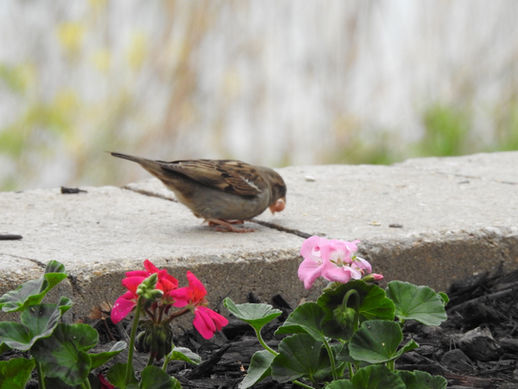House Sparrow
Common Name: House Sparrow.
Scientific Name: Passer Domesticus.
What to look for? The House Sparrow is a chunky full-breasted bird. It has a round head and a stout bill. One distinguishing characteristic is the gray crown. House Sparrows also have white cheeks, a black bib, and a chestnut neck. The female House Sparrow is a plain buffy-brown overall with gray-brown underparts. Their backs have noticeable stripes of buff, black, and brown. House Sparrows are not related to other North American sparrows, and are differently shaped.
Where can they be found at Carillon Stonegate Pond? House Sparrows are year-around residents and will be found in our backyards and under our feeders. Look for them walking or hopping on the ground or flitting through branches and bushes. And you will not find just one as they forage in groups, including with other birds. Also, check your gutters and hanging planters.
How big are they? The House Sparrow averages just over six inches in length. And their wingspan is just approximately nine inches. They weigh in at around one ounce.
What are their flight patterns? The flight of a House Sparrow is more direct, and often higher, than native sparrows. Its flight resembles more the house finch than a native sparrow with an undulating style.
How else do they behave? Apparently, somewhat badly! The House Sparrow was introduced from Europe into North America during the middle to late 1800’s into urban and rural locations. The House Sparrow competes with native birds for food and nest sites. House Sparrows are social and feed in crowded flocks, often squabbling over crumbs or seeds on the ground. House Sparrows are closely associated with people and their buildings.
What’s for dinner? House Sparrows eat mostly grains and seeds. In summer, House Sparrows eat insects and feed them to their young. In urban areas, they will scavenge any crumbs of food left by people.
Where do they take up residence? House Sparrows are now common across all of North America except Alaska and far northern Canada. They are found across the world. House Sparrows will reside in most places where there are houses or other buildings. In fact, House Sparrows are not to be found in undisturbed forests and open grasslands.
When and where do they breed and nest? Mating occurs throughout the breeding season from March to August. The House Sparrow prefers to nest in man-made structures such as eaves or walls of buildings, streetlights, and nest boxes instead of in natural nest sites such as holes in trees. A mated pair can have up to four broods in a single season.
Where do they migrate? House Sparrows are generally year-round residents, including here in Illinois.
What is their conservation status? There is low concern. According to the North American Breeding Bird Survey, the House Sparrows has seen slight decreases in populations. Partners in Flight estimates the global breeding population at 740 million.
Do they make any interesting sounds? House Sparrows have a rather simple song of one or a series of “cheep” or “chirrup” notes. Here is a link to the sounds of the House Sparrow.
Interesting Facts About the House Sparrow:
-
The House Sparrow was introduced into Brooklyn, New York, in 1851 and by 1900 it had spread to the Rocky Mountains. Two more introductions in the early 1870s, in San Francisco and Salt Lake City, aided the bird’s spread throughout the West.
-
The House Sparrow takes frequent dust baths. It throws soil and dust over its body feathers, just as if it were bathing with water.
-
House Sparrows have proved to be an excellent model organism for many avian biological studies with some 5,000 scientific papers published using the House Sparrow as the study species.
-
House Sparrows aggressively defend their nest holes and sometimes evict other birds from nest holes, including Eastern Bluebirds, Purple Martins, and Tree Swallows.
-
House Sparrows in flocks have a pecking order much the way chickens in a farmyard do. Males with larger patches of black tend to be older and dominant over males with less black.
-
House Sparrows have been seen stealing food from American Robins and piercing flowers to drain them of nectar.
-
The oldest recorded House Sparrow was approximately 16 years old.
For more information on the House Sparrow and sources of information used in this blog (these are the sources that I am using to learn as I blog), please visit All About Birds, Audubon Society and National Geographic. And the Cornell Lab of Ornithology provides a wonderful source of information for anyone interested in learning more about birds.
The Carillon at Stonegate community is very fortunate to have a variety of wetland, forest and prairie environments conducive to a variety of birds and other wildlife, plants and insects. Our community and the Kane County Forest Preserve do an exceptional job in maintaining this natural environment – both for the benefit of the birds and wildlife and for our residents to enjoy.
Take a hike and see what you can find – and identify!





